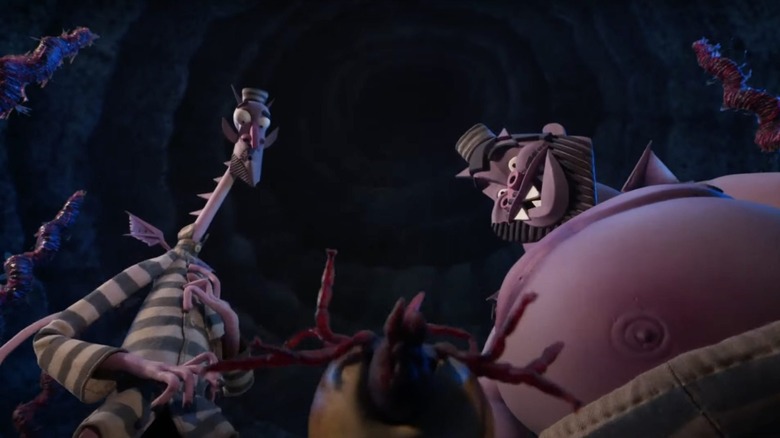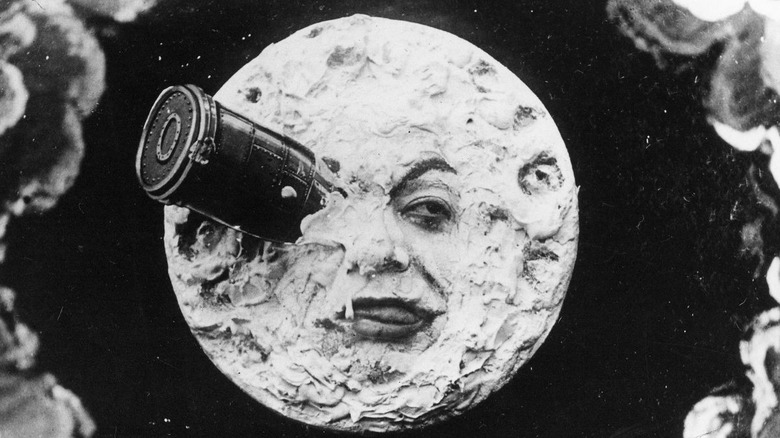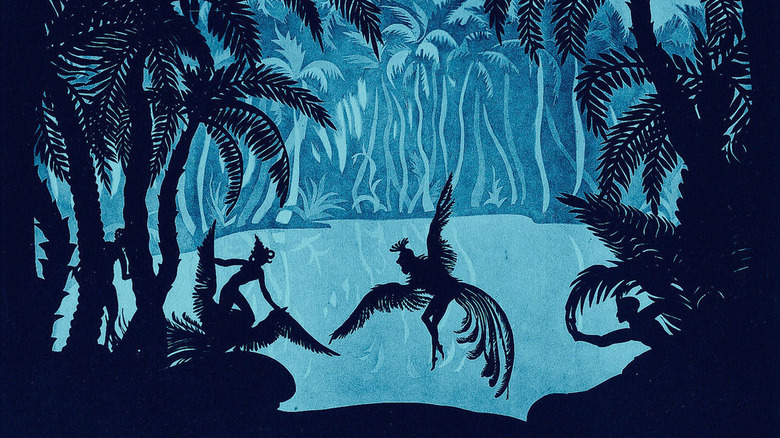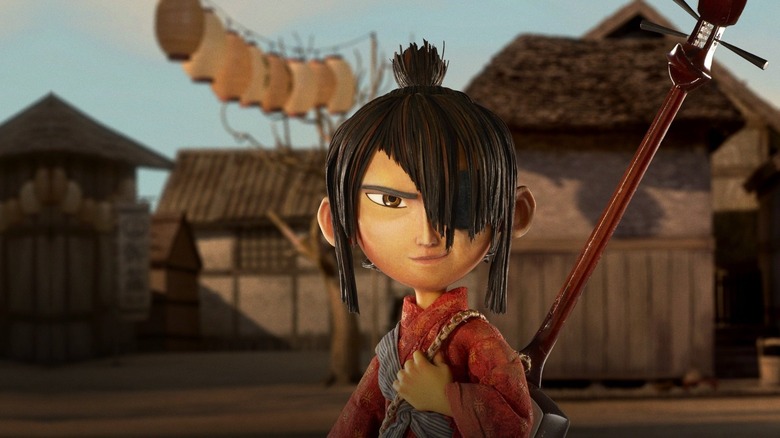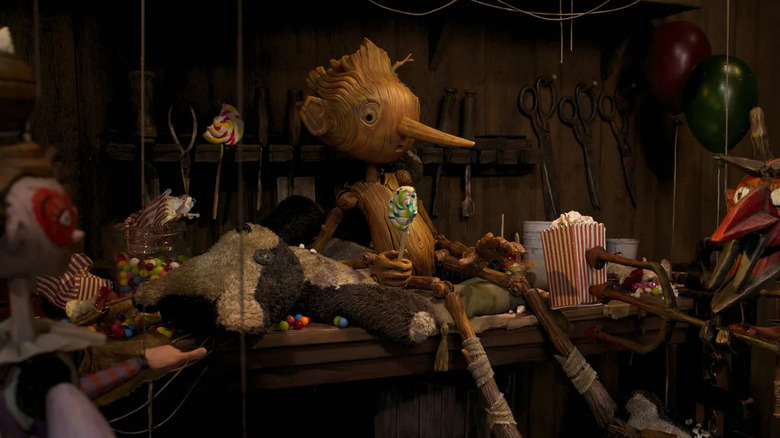Wendell & Wild And Guillermo Del Toro's Pinocchio Prove There's Still Life To Be Found In Stop-Motion Animation
Animation fans are truly being treated in 2022. Pixar released one of their best ever films, "Turning Red," while DreamWorks dropped an underrated caper in the form of "The Bad Guys." Richard Linklater turned to rotoscope for "Apollo 10 ½" and "Dragon Ball Super: Super Hero" became an unexpected box office hit in North America. To top it off, we're getting not one but two stop-motion animated features: Guillermo del Toro's take on the classic story of "Pinocchio," and Henry Selick's return to the medium with the horror-comedy "Wendell and Wild."
Selick has long been one of the stalwarts of stop-motion in American animation thanks to iconic spooky season films like "The Nightmare Before Christmas" and "Coraline," while del Toro turned to the medium for his decade-long passion project and has received some of the best reviews of his starry career for his troubles. It's hard not to be enthusiastic about this brief spark of life for stop-motion, especially as animation on the big and small screen seems to be in a tough spot.
American animation has long abandoned 2D hand-drawn work, with 3D CGI work dominating the major studio releases. Even Disney, who made their name by pioneering the lush detail and beauty of traditional animation, have abandoned the style that made them icons in favor of 3D. The mainstream market of animated cinema, the kind that gets the widest releases and reaches the most people, follows a very limited visual palate. That's not to say that it can't be gorgeous or that it hasn't expanded the scope of the medium. Yet it is dishearteningly narrow a viewpoint to hold. Studios like Laika and Aardman are keeping stop-motion alive for general audiences but they're fighting an uphill battle. At the heart of this quandary is yet another reminder of how the mainstream entertainment industry continues to view animation as something lesser than live-action, an artistically bereft perspective to be used only for quickly churned-out kids' stuff and not much else. It's a shameful indictment of the Hollywood machine, of course, but it also demonstrates a disheartening ignorance of cinematic history. For almost a century, stop-motion has been a pioneering tool of movie-making.
What is stop-motion animation?
First, an explanation of what stop-motion animation actually is. Animation at its core is the manipulation of still images to create motion. Stop-motion uses physical objects rather than drawings, moved in tiny increments and photographed one by one until they create a full scene. Through this process, any kind of object can be animated, from puppets to clay to paper to the furniture of your living room.
Stop-motion essentially formed the backbone of what would become film, thanks to inventions like the zoetrope. Many early silent films used a technique known as the stop trick, wherein the camera is temporarily stopped during the recording of a scene to create a change before filming continues. It can be seen in works as iconic as the films of Georges Méliès, who utilized it to create fantastical possibilities such as a rocket crash-landing into the moon's eye. Spanish filmmaker Segundo de Chomón made many short films with the stop trick, with one of his most famous featuring his wife, Julienne Mathieu, having her hair brushed and styled as if by magic.
A brief history of stop-motion animation
Soon, animators started working with other mediums to create more fully formed stop-motion animation. Willis O'Brien created the 1915 short "The Dinosaur and the Missing Link: A Prehistoric Tragedy," using clay models of cavemen and prehistoric creatures. German director Lotte Reiniger created the oldest surviving animated feature with 1926's "The Adventures of Prince Achmed," using silhouette cut-outs and a back-light with color tinting. Soon, stop-motion moved into the world of live-action as a way to bring the unreal to our cinematic reality. O'Brien created the eponymous apes from "King Kong" and "Mighty Joe Young." He later became the mentor of the one and only Ray Harryhausen, perhaps the most famous master of stop-motion and its power to create the impossible. He redefined what fantasy cinema could be with his work in "Clash of the Titans" and "Jason and the Argonauts," to name but two of his achievements. The advent of CGI and its increasing photo-realism essentially killed off this format for effects purposes, but it could still be found in films as iconic as "Star Wars" and "Robocop."
British children's animation frequently used stop-motion to create low-cost but charmingly shabby shows like "Bagpuss" and "The Clangers" that aged much better than much of the cheaply made 2D cartoons of the era. In the '70s, Peter Lord and David Sproxton formed Aardman Animations, which defined stop-motion for a whole new era of entertainment. Eventually, they would become multi-Oscar winners with the "Wallace and Gromit" series but they started out doing TV ads and, perhaps most famously, the music video for Peter Gabriel's "Sledgehammer." Throughout this era, stop-motion was also seen as a more artistic alternative to the traditional Hollywood fare defined by Disney. Czech surrealist filmmaker Jan Švankmajer's work brought a kind of grotesquery to the medium that inspired the likes of Terry Gilliam. In 1975, filmmaker Will Vinton and sculptor Bob Gardiner joined forces to create "Closed Mondays," which became the first stop-motion film to win an Oscar.
The variety of stop-motion techniques could be found throughout the '90s and 2000s, even as Disney revived the 2D format to great acclaim with its renaissance era and DreamWorks and Pixar pushed 3D as the new default mode. Trey Parker and Matt Stone turned crude paper cut-outs into one of the most profane and beloved comedies of all time with "South Park." Charlie Kaufman and Wes Anderson turned to stop-motion for their animation debuts, "Anomalisa" and "Fantastic Mr. Fox." Laika was founded and created gorgeous works such as "Kubo and the Two Strings" and "Coraline." Seth Green's "Robot Chicken" turned action figures and toys into animated skits of geek culture parodies.
Why is stop-motion so rarely used?
While stop-motion has been in rude health in terms of critical acclaim, it hasn't always delighted the industry. Really, it's seen as a niche rather than a legitimate form of the medium to stand alongside the big boys of 3D. Animation is a field notorious for cost-cutting measures, including the over-working of employees and discouragement of unionizing efforts. It's an industry where studios will export resources to cheaper countries and places with much slacker labor laws. While some studios are still known for putting big budgets into animation, particularly Disney, nowadays it's not unusual to see budgets and production times slashed (this is an issue that also plagues the VFX world.) Since animation is scorned as mere kiddie fare, it's seen as unworthy of sturdy financial and creative investment. That's a problem for stop-motion, which requires massive amounts of both to succeed. Yet it's still cheaper than many 3D films. For instance, the reported budget for del Toro's "Pinocchio" is $35 million. By contrast, Universal spent about $80 million on "Minions: The Rise of Gru," and that's on the low end for such a movie.
Stop-motion requires a vast and specifically trained force of animators, an astonishing level of detail, and years of pre-production. Aardman Animation can spend a full day of work on what amounts to four seconds of footage. Make a mistake and it's not something one can easily clean up with CGI. It's not an art form that can easily be regurgitated for merchandise, franchising, and all of the other aspects of intellectual property that studios prize more than the films themselves. Sadly, most stop-motion films haven't been box office smashes, so there's less drive to invest in them.
The unique artistry of stop-motion
It's a shame because stop-motion provides artistic and stylistic opportunities that other forms of animation don't have. The opportunity to use literally any solid object and turn it into a living thing through this process has never been fully taken advantage of. Consider the homemade charm of the "Wallace and Gromit" films, where you can literally see the animators' fingerprints on the characters. Or the knowing anti-realism of Laika's best films. The animator Adam Pesapane, who works under the name PES, uses items as varied as poker chips, boxing gloves, and bubble wrap to create bizarre mini-tales that force audiences to change how they see the more mundane aspects of life. Henry Selick's horror tastes are perfectly suited for the medium, which allows for an uncanny quality that seems ideal for scares. No two stop-motion films look the same, whereas often it feels like every 3D animated project came from the same assembly line.
Hollywood isn't known for taking the path less travelled. It finds a thing that works and runs it into the ground. That means that stop-motion is often left on the shelf, something for niche artistic projects or cult entertainment but not the mainstream. Even when it's critically adored, the industry doesn't seem interested in acknowledging that (only one stop-motion film has ever won Best Animated Feature at the Oscars, a category almost exclusively dominated by Disney/Pixar's 3D films.) This is why we have to relish stop-motion when we get it on the scale and adoring detail of Selick and del Toro's latest projects. They're such rarities, such diamonds in the rough, and each new one seems like it has the potential to be the last of its kind in Hollywood. So, this spooky season, let stop-motion films provide you with the perfect Halloween entertainment.
